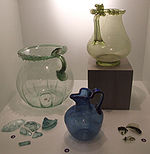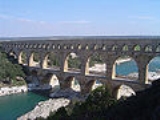
Roman technology
Encyclopedia


Roman commerce
Roman trade was the engine that drove the Roman economy of the late Republic and the early Empire. Fashions and trends in historiography and in popular culture have tended to neglect the economic basis of the empire in favor of the lingua franca of Latin and the exploits of the Roman legions...
and Roman military possible over nearly a thousand years.
The Roman Empire
Roman Empire
The Roman Empire was the post-Republican period of the ancient Roman civilization, characterised by an autocratic form of government and large territorial holdings in Europe and around the Mediterranean....
had the most advanced set of technologies of its time, some of which was lost during the turbulent eras of Late Antiquity
Late Antiquity
Late Antiquity is a periodization used by historians to describe the time of transition from Classical Antiquity to the Middle Ages, in both mainland Europe and the Mediterranean world. Precise boundaries for the period are a matter of debate, but noted historian of the period Peter Brown proposed...
and the early Middle Ages
Early Middle Ages
The Early Middle Ages was the period of European history lasting from the 5th century to approximately 1000. The Early Middle Ages followed the decline of the Western Roman Empire and preceded the High Middle Ages...
. Gradually, some of the technological feats of the Romans were rediscovered and/or improved upon, while others went ahead of what the Romans had done during the Middle Ages
Middle Ages
The Middle Ages is a periodization of European history from the 5th century to the 15th century. The Middle Ages follows the fall of the Western Roman Empire in 476 and precedes the Early Modern Era. It is the middle period of a three-period division of Western history: Classic, Medieval and Modern...
and the beginning of the Modern Era. Several Roman technological feats in different areas like civil engineering, construction materials, transport technology, and some inventions such as the mechanical reaper, were surprising achievements until the 19th century, and some, such as the arch
Arch
An arch is a structure that spans a space and supports a load. Arches appeared as early as the 2nd millennium BC in Mesopotamian brick architecture and their systematic use started with the Ancient Romans who were the first to apply the technique to a wide range of structures.-Technical aspects:The...
, have remained untouched to this day.
Innovation and progress
Small scale innovation was common as devices were gradually made more efficient, such as the improvement of the overshot water wheel and the improvements in wagon construction. Technology could and did evolve. The scale of the Empire encouraged the geographical spread of innovations. The ideal Roman citizen was an articulate veteran soldier who could wisely govern a large family household, which was supported by slave labor. Innovators did have some prestige; PlinyPliny the Elder
Gaius Plinius Secundus , better known as Pliny the Elder, was a Roman author, naturalist, and natural philosopher, as well as naval and army commander of the early Roman Empire, and personal friend of the emperor Vespasian...
, for example, often records their names, or has some story to account for the innovation. Romans also knew enough history to be aware that technological change had occurred in the past and brought benefits. Military innovation was always valued. One text, De Rebus Bellicis
De Rebus Bellicis
De rebus bellicis is a 4th or 5th century anonymous work about war machines used by the Roman army of the time. It was written after the death of Constantine I , and before the fall of the Western Roman Empire...
, devoted to a number of innovations in military machinery, has survived.
The apparent period in which technological progress was fastest and greatest was during the 2nd century and 1st century BC, which was the period in which Roman power greatly increased. Innovation continued until the fall of the Empire, and it would take hundreds of years for all of its technological advancements to be rediscovered by other civilizations. Our understanding of Roman technology is provided by Pliny's Naturalis Historia
Naturalis Historia
The Natural History is an encyclopedia published circa AD 77–79 by Pliny the Elder. It is one of the largest single works to have survived from the Roman Empire to the modern day and purports to cover the entire field of ancient knowledge, based on the best authorities available to Pliny...
, the De Architectura
De architectura
' is a treatise on architecture written by the Roman architect Vitruvius and dedicated to his patron, the emperor Caesar Augustus, as a guide for building projects...
of Vitruvius
Vitruvius
Marcus Vitruvius Pollio was a Roman writer, architect and engineer, active in the 1st century BC. He is best known as the author of the multi-volume work De Architectura ....
and the De aquaeductu
De aquaeductu
' is a two-book official report given to the emperor on the state of the aqueducts of Rome, and was written by Julius Sextus Frontinus at the end of the 1st century AD. It is also known as or . It is the earliest official report of an investigation made by a distinguished citizen on Roman...
of Frontinus, all reliable works which give good information, and many inventions they mention have been confirmed by modern archaeology
Archaeology
Archaeology, or archeology , is the study of human society, primarily through the recovery and analysis of the material culture and environmental data that they have left behind, which includes artifacts, architecture, biofacts and cultural landscapes...
. By the beginning of the 1st century, most of what is considered today as typical Roman technology was already invented and refined, such as concrete
Concrete
Concrete is a composite construction material, composed of cement and other cementitious materials such as fly ash and slag cement, aggregate , water and chemical admixtures.The word concrete comes from the Latin word...
, plumbing
Plumbing
Plumbing is the system of pipes and drains installed in a building for the distribution of potable drinking water and the removal of waterborne wastes, and the skilled trade of working with pipes, tubing and plumbing fixtures in such systems. A plumber is someone who installs or repairs piping...
facilities, cranes
Crane (machine)
A crane is a type of machine, generally equipped with a hoist, wire ropes or chains, and sheaves, that can be used both to lift and lower materials and to move them horizontally. It uses one or more simple machines to create mechanical advantage and thus move loads beyond the normal capability of...
, wagon technology, mechanized harvesting machines, domes, the arch
Arch
An arch is a structure that spans a space and supports a load. Arches appeared as early as the 2nd millennium BC in Mesopotamian brick architecture and their systematic use started with the Ancient Romans who were the first to apply the technique to a wide range of structures.-Technical aspects:The...
in building practice, wine
Wine
Wine is an alcoholic beverage, made of fermented fruit juice, usually from grapes. The natural chemical balance of grapes lets them ferment without the addition of sugars, acids, enzymes, or other nutrients. Grape wine is produced by fermenting crushed grapes using various types of yeast. Yeast...
and oil
Oil
An oil is any substance that is liquid at ambient temperatures and does not mix with water but may mix with other oils and organic solvents. This general definition includes vegetable oils, volatile essential oils, petrochemical oils, and synthetic oils....
presses, and glass blowing.
The energy constraint
All technology uses energy to transform the material into a desirable object or uses some form of mechanics combined with another form to make something better. The cheaper energy is, the wider the class of technologies that are considered economic. This is why technological history can be seen as a succession of ages defined by energy type i.e. human, animal, water, peat, coal, and oil. The Romans used water power, and watermills were common throughout the Empire, especially to the end of the first century AD. They were used for corn milling, sawing timber and crushing ore. They exploited wood and coal for heating. There were huge reserves of wood, peat and coal in the Roman Empire, but they were all in the wrong place. Wood could be floated down rivers to the major urban centres but otherwise it was a very poor fuel, being heavy for its calorific value. If this was improved by being processed into charcoal, it was bulky. Nor was wood ever available in any concentration. Diocletian's Price EdictEdict on Maximum Prices
The Edict on Maximum Prices was issued in 301 by Roman Emperor Diocletian....
can give us a glimpse of the economics of transporting wood. The maximum price of a wagon load of 1,200 lbs of wood was 150 d.(denari). The maximum freight charge per mile for the same wagon load was 20 d. per mile. Room heating was normally better done by charcoal braziers than hypocausts. But hypocaust
Hypocaust
A hypocaust was an ancient Roman system of underfloor heating, used to heat houses with hot air. The word derives from the Ancient Greek hypo meaning "under" and caust-, meaning "burnt"...
s did allow them to exploit any poor-quality smoky fuels like straw, vine prunings and small wood locally available. Hypocausts also allowed them to generate a humid heat for their baths.
The Romans worked almost all the coalfields of England that outcropped on the surface, by the end of the 2nd century (Smith 1997; 323). But there is no evidence that this exploitation was on any scale. After c.200 AD the commercial heart of the Empire was in Africa and the East where the climate severely limited timber growth. There was no large coalfield on the edge of the Mediterranean.
Nevertheless, the Romans were the first culture to assemble all essential components of the much later steam engine
Steam engine
A steam engine is a heat engine that performs mechanical work using steam as its working fluid.Steam engines are external combustion engines, where the working fluid is separate from the combustion products. Non-combustion heat sources such as solar power, nuclear power or geothermal energy may be...
:
However, the aeolipile was a reaction engine
Reaction engine
A reaction engine is an engine or motor which provides propulsion by expelling reaction mass, in accordance with Newton's third law of motion...
, inefficient as a stationary engine. The first useful steam engine
Newcomen steam engine
The atmospheric engine invented by Thomas Newcomen in 1712, today referred to as a Newcomen steam engine , was the first practical device to harness the power of steam to produce mechanical work. Newcomen engines were used throughout Britain and Europe, principally to pump water out of mines,...
did not use steam pressure at all, but followed up a scientific advance in understanding air pressure.
Craft basis
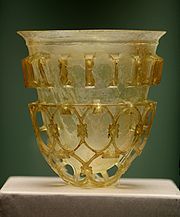
Engineering
Engineering is the discipline, art, skill and profession of acquiring and applying scientific, mathematical, economic, social, and practical knowledge, in order to design and build structures, machines, devices, systems, materials and processes that safely realize improvements to the lives of...
is used today to describe the technical feats of the Romans. The Greek words used were mechanic or machine-maker or even mathematician which had a much wider meaning than now. There were a large number of engineers employed by the army. The most famous engineer of this period was Apollodorus of Damascus
Apollodorus of Damascus
Apollodorus of Damascus was a Greek engineer, architect, designer and sculptor who flourished during the 2nd century AD, from Damascus, Roman Syria. He was a favourite of Trajan, for whom he constructed Trajan's Bridge over the Danube for the 105-106 campaign in Dacia. He also designed the Forum...
. Normally each trade, each group of artisan
Artisan
An artisan is a skilled manual worker who makes items that may be functional or strictly decorative, including furniture, clothing, jewellery, household items, and tools...
s—stonemasons, glass
Glass
Glass is an amorphous solid material. Glasses are typically brittle and optically transparent.The most familiar type of glass, used for centuries in windows and drinking vessels, is soda-lime glass, composed of about 75% silica plus Na2O, CaO, and several minor additives...
blowers, surveyors, etc.—within a project had its own practice of masters and apprentices, and many tried to keep their trade secrets, passing them on solely by word of mouth, a system still in use today by those who do not want to patent
Patent
A patent is a form of intellectual property. It consists of a set of exclusive rights granted by a sovereign state to an inventor or their assignee for a limited period of time in exchange for the public disclosure of an invention....
their inventions. Writers such as Vitruvius
Vitruvius
Marcus Vitruvius Pollio was a Roman writer, architect and engineer, active in the 1st century BC. He is best known as the author of the multi-volume work De Architectura ....
, Pliny the Elder
Pliny the Elder
Gaius Plinius Secundus , better known as Pliny the Elder, was a Roman author, naturalist, and natural philosopher, as well as naval and army commander of the early Roman Empire, and personal friend of the emperor Vespasian...
and Frontinus published widely on many different technologies, and there was a corpus of manuals on basic mathematics and science such as the many books by Archimedes
Archimedes
Archimedes of Syracuse was a Greek mathematician, physicist, engineer, inventor, and astronomer. Although few details of his life are known, he is regarded as one of the leading scientists in classical antiquity. Among his advances in physics are the foundations of hydrostatics, statics and an...
, Ctesibius
Ctesibius
Ctesibius or Ktesibios or Tesibius was a Greek inventor and mathematician in Alexandria, Ptolemaic Egypt. He wrote the first treatises on the science of compressed air and its uses in pumps...
, Heron (a.k.a. Hero of Alexandria)
Hero of Alexandria
Hero of Alexandria was an ancient Greek mathematician and engineerEnc. Britannica 2007, "Heron of Alexandria" who was active in his native city of Alexandria, Roman Egypt...
, Euclid
Euclid
Euclid , fl. 300 BC, also known as Euclid of Alexandria, was a Greek mathematician, often referred to as the "Father of Geometry". He was active in Alexandria during the reign of Ptolemy I...
and so on. Not all of the manuals which were available to the Romans have survived, as lost works illustrate.
Much of what is known of Roman technology comes indirectly from archaeology and from the third-hand accounts of Latin
Latin
Latin is an Italic language originally spoken in Latium and Ancient Rome. It, along with most European languages, is a descendant of the ancient Proto-Indo-European language. Although it is considered a dead language, a number of scholars and members of the Christian clergy speak it fluently, and...
texts copied from Arabic
Arabic language
Arabic is a name applied to the descendants of the Classical Arabic language of the 6th century AD, used most prominently in the Quran, the Islamic Holy Book...
texts, which were in turn copied from the Greek
Greek language
Greek is an independent branch of the Indo-European family of languages. Native to the southern Balkans, it has the longest documented history of any Indo-European language, spanning 34 centuries of written records. Its writing system has been the Greek alphabet for the majority of its history;...
texts of scholars such as Hero of Alexandria
Hero of Alexandria
Hero of Alexandria was an ancient Greek mathematician and engineerEnc. Britannica 2007, "Heron of Alexandria" who was active in his native city of Alexandria, Roman Egypt...
or contemporary travelers who had observed Roman technologies in action. Writers like Pliny the Elder
Pliny the Elder
Gaius Plinius Secundus , better known as Pliny the Elder, was a Roman author, naturalist, and natural philosopher, as well as naval and army commander of the early Roman Empire, and personal friend of the emperor Vespasian...
and Strabo
Strabo
Strabo, also written Strabon was a Greek historian, geographer and philosopher.-Life:Strabo was born to an affluent family from Amaseia in Pontus , a city which he said was situated the approximate equivalent of 75 km from the Black Sea...
had enough intellectual curiosity to make note of the inventions they saw during their travels, although their typically brief descriptions often arouse discussion as to their precise meaning. On the other hand, Pliny is perfectly clear when describing gold mining
Gold mining
Gold mining is the removal of gold from the ground. There are several techniques and processes by which gold may be extracted from the earth.-History:...
, his text in book XXXIII
Naturalis Historia
The Natural History is an encyclopedia published circa AD 77–79 by Pliny the Elder. It is one of the largest single works to have survived from the Roman Empire to the modern day and purports to cover the entire field of ancient knowledge, based on the best authorities available to Pliny...
having been confirmed by archaeology
Archaeology
Archaeology, or archeology , is the study of human society, primarily through the recovery and analysis of the material culture and environmental data that they have left behind, which includes artifacts, architecture, biofacts and cultural landscapes...
and field-work at such sites as Las Medulas
Las Médulas
Las Médulas is a historical site near the town of Ponferrada in the region of El Bierzo , which used to be the most important gold mine in the Roman Empire...
and Dolaucothi.
Engineering and construction
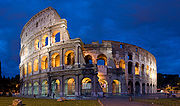
Aqueduct
An aqueduct is a water supply or navigable channel constructed to convey water. In modern engineering, the term is used for any system of pipes, ditches, canals, tunnels, and other structures used for this purpose....
s, dams
DAMS
Driot-Arnoux Motorsport is a racing team from France, involved in many areas of motorsports. DAMS was founded in 1988 by Jean-Paul Driot and former Formula One driver René Arnoux. It is headquartered near Le Mans, only 2 km from the Bugatti Circuit.- History :The year after its foundation,...
, bridge
Bridge
A bridge is a structure built to span physical obstacles such as a body of water, valley, or road, for the purpose of providing passage over the obstacle...
s, and amphitheaters. They were also responsible for many innovations to roads, sanitation, and construction in general. Roman architecture in general was greatly influenced by the Etruscans. Most of the columns and arches seen in famous Roman architecture were adopted from the Etruscan civilization.
In the Roman Empire, cements made from pozzolanic
Pozzolana
Pozzolana, also known as pozzolanic ash , is a fine, sandy volcanic ash. Pozzolanic ash was first discovered and dug in Italy, at Pozzuoli. It was later discovered at a number of other sites as well...
ash/pozzolana and an aggregate made from pumice were used to make a concrete
Concrete
Concrete is a composite construction material, composed of cement and other cementitious materials such as fly ash and slag cement, aggregate , water and chemical admixtures.The word concrete comes from the Latin word...
very similar to modern Portland cement concrete. In 20s BC the architect Vitruvius
Vitruvius
Marcus Vitruvius Pollio was a Roman writer, architect and engineer, active in the 1st century BC. He is best known as the author of the multi-volume work De Architectura ....
described a low-water-content method for mixing concrete. The Romans found out that insulated glazing
Insulated glazing
Insulated glazing also known as double glazing are double or triple glass window panes separated by an air or other gas filled space to reduce heat transfer across a part of the building envelope....
(or "double glazing") improved greatly on keeping buildings warm, and this technique was used in the construction of public baths
Thermae
In ancient Rome, thermae and balnea were facilities for bathing...
.
Another truly original process which was born in the empire was the practice of glassblowing
Glassblowing
Glassblowing is a glassforming technique that involves inflating molten glass into a bubble, or parison, with the aid of a blowpipe, or blow tube...
, which started in Syria and spread in about one generation in the empire.
Machines
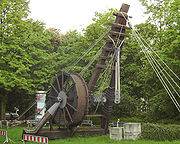
Hero of Alexandria
Hero of Alexandria was an ancient Greek mathematician and engineerEnc. Britannica 2007, "Heron of Alexandria" who was active in his native city of Alexandria, Roman Egypt...
, but may have already been in use when he mentioned it in his Mechanica III.
Cranes were used for construction work and possibly to load and unload ships at their ports, although for the latter use there is according to the “present state of knowledge” still no evidence. Most cranes were capable of lifting about 6-7 tons of cargo, and according to a relief shown on Trajan's column
Trajan's Column
Trajan's Column is a Roman triumphal column in Rome, Italy, which commemorates Roman emperor Trajan's victory in the Dacian Wars. It was probably constructed under the supervision of the architect Apollodorus of Damascus at the order of the Roman Senate. It is located in Trajan's Forum, built near...
were worked by treadwheel
Treadwheel
A treadwheel is a form of animal engine typically powered by humans. It may resemble a water wheel in appearance, and can be worked either by a human treading paddles set into its circumference , or by a human or animal standing inside it .Uses of treadwheels included raising water, to power...
.
Roads

Way stations providing refreshments were maintained by the government at regular intervals along the roads. A separate system of changing stations for official and private couriers was also maintained. This allowed a dispatch to travel a maximum of 800 kilometres (497.1 mi) in 24 hours by using a relay of horses.
The roads were constructed by digging a pit along the length of the intended course, often to bedrock
Bedrock
In stratigraphy, bedrock is the native consolidated rock underlying the surface of a terrestrial planet, usually the Earth. Above the bedrock is usually an area of broken and weathered unconsolidated rock in the basal subsoil...
. The pit was first filled with rocks, gravel or sand and then a layer of concrete. Finally they were paved with polygonal rock slabs. Roman roads are considered the most advanced roads built until the early 19th century. Bridges were constructed over waterways. The roads were resistant to floods and other environmental hazards. After the fall of the Roman empire the roads were still usable and used for more than 1000 years.
Aqueducts

Rome
Rome is the capital of Italy and the country's largest and most populated city and comune, with over 2.7 million residents in . The city is located in the central-western portion of the Italian Peninsula, on the Tiber River within the Lazio region of Italy.Rome's history spans two and a half...
itself was supplied by eleven aqueducts made of limestone that provided the city with over 1 million cubic metres of water each day, sufficient for 3.5 million people even in modern day times, and with a combined length of 350 kilometres (217.5 mi).
Water inside the aqueducts depended entirely on gravity. The raised stone channels in which the water travelled were slightly slanted. The water was carried directly from mountain springs. After it had gone through the aqueduct, the water was collected in tanks and fed through pipes to fountains, toilets, etc.
The main aqueducts in Ancient Rome were the Aqua Claudia and the Aqua Marcia.
Most aqueducts were constructed below the surface with only small portions above ground supported by arches. The longest Roman aqueduct, 178 kilometres (110.6 mi) in length, was traditionally assumed to be that which supplied the city of Carthage
Carthage
Carthage , implying it was a 'new Tyre') is a major urban centre that has existed for nearly 3,000 years on the Gulf of Tunis, developing from a Phoenician colony of the 1st millennium BC...
. The complex system built to supply Constantinople had its most distant supply drawn from over 120 km away along a sinuous route of more than 336 km.
Roman aqueducts were built to remarkably fine tolerances, and to a technological standard that was not to be equaled until modern times. Powered entirely by gravity, they transported very large amounts of water very efficiently. Sometimes, where depressions deeper than 50 metres had to be crossed, inverted siphons were used to force water uphill. An aqueduct also supplied water for the overshot wheels at Barbegal
Barbegal aqueduct and mill
The Barbegal aqueduct and mill is a Roman watermill complex located on the territory of the commune of Fontvieille, near the town of Arles, in southern France. The complex has been referred to as "the greatest known concentration of mechanical power in the ancient world"...
in Roman Gaul
Roman Gaul
Roman Gaul consisted of an area of provincial rule in the Roman Empire, in modern day France, Belgium, Luxembourg, and western Germany. Roman control of the area lasted for less than 500 years....
, a complex of water mills hailed as "the greatest known concentration of mechanical power in the ancient world".
Bridges
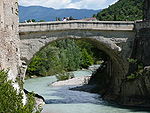
Arch
An arch is a structure that spans a space and supports a load. Arches appeared as early as the 2nd millennium BC in Mesopotamian brick architecture and their systematic use started with the Ancient Romans who were the first to apply the technique to a wide range of structures.-Technical aspects:The...
as its basic structure. Most utilized concrete as well.
Built in 142 BC, the Pons Aemilius
Pons Aemilius
The Pons Aemilius , today called Ponte Rotto, is the oldest Roman stone bridge in Rome, Italy. Preceded by a wooden version, it was rebuilt in stone in the 2nd century BC...
, later named Ponte Rotto (broken bridge) is the oldest Roman stone bridge in Rome, Italy. The biggest Roman bridge was Trajan's bridge
Trajan's bridge
Trajan's Bridge or Bridge of Apollodorus over the Danube was a Roman segmental arch bridge, the first to be built over the lower Danube. For more than a thousand years, it was the longest arch bridge in the world, in terms of both total and span length...
over the lower Danube, constructed by Apollodorus of Damascus
Apollodorus of Damascus
Apollodorus of Damascus was a Greek engineer, architect, designer and sculptor who flourished during the 2nd century AD, from Damascus, Roman Syria. He was a favourite of Trajan, for whom he constructed Trajan's Bridge over the Danube for the 105-106 campaign in Dacia. He also designed the Forum...
, which remained for over a millennium the longest bridge to have been built both in terms of overall and span length. They were most of the time at least 60 feet above the body of water.
An example of temporary military bridge construction are the two Caesar's Rhine bridges
Caesar's Rhine bridges
Caesar's Bridge across the Rhine, the first two bridges to cross the Rhine River, were built by Julius Caesar and his legionaries during the Gallic War in 55 BC and 53 BC, respectively...
.
Dams
They also built many damsDAMS
Driot-Arnoux Motorsport is a racing team from France, involved in many areas of motorsports. DAMS was founded in 1988 by Jean-Paul Driot and former Formula One driver René Arnoux. It is headquartered near Le Mans, only 2 km from the Bugatti Circuit.- History :The year after its foundation,...
for water collection, such as the Subiaco Dams
Subiaco Dams
The Subiaco Dams were a group of three Roman gravity dams at Subiaco, Lazio, Italy, devised as pleasure lakes for emperor Nero . The biggest one was the highest dam in the Roman Empire, and even in the world until its destruction in 1305.- See also :...
, two of which fed Anio Novus
Anio Novus
Anio Novus is an aqueduct of Rome. Together with the Aqua Claudia, it was begun by emperor Caligula in 38 AD and completed in 52 AD by Claudius, who dedicated them both on August 1.-Details:...
, one of the largest aqueducts of Rome
Rome
Rome is the capital of Italy and the country's largest and most populated city and comune, with over 2.7 million residents in . The city is located in the central-western portion of the Italian Peninsula, on the Tiber River within the Lazio region of Italy.Rome's history spans two and a half...
. They built 72 dams in just one country, Spain
Spain
Spain , officially the Kingdom of Spain languages]] under the European Charter for Regional or Minority Languages. In each of these, Spain's official name is as follows:;;;;;;), is a country and member state of the European Union located in southwestern Europe on the Iberian Peninsula...
and many more are known across the Empire, some of which are still in use. At one site, Montefurado in Galicia, they appear to have built a dam across the river Sil to expose alluvial gold deposits in the bed of the river. The site is near the spectacular Roman gold mine of Las Medulas
Las Médulas
Las Médulas is a historical site near the town of Ponferrada in the region of El Bierzo , which used to be the most important gold mine in the Roman Empire...
. Several earthen dams are known from Britain
Great Britain
Great Britain or Britain is an island situated to the northwest of Continental Europe. It is the ninth largest island in the world, and the largest European island, as well as the largest of the British Isles...
, including a well-preserved example from Roman Lanchester, Longovicium
Longovicium
Longovicium was an auxiliary fort on Dere Street, in the Roman province of Britannia Inferior. It is located just southwest of Lanchester in the English county of Durham, roughly to the west of the city of Durham and from Consett.-History:Longovicium was situated between the forts of...
, where it may have been used in industrial-scale smithing or smelting
Smelting
Smelting is a form of extractive metallurgy; its main use is to produce a metal from its ore. This includes iron extraction from iron ore, and copper extraction and other base metals from their ores...
, judging by the piles of slag found at this site in northern England. Tanks for holding water are also common along aqueduct systems, and numerous examples are known from just one site, the gold mines at Dolaucothi in west Wales
Wales
Wales is a country that is part of the United Kingdom and the island of Great Britain, bordered by England to its east and the Atlantic Ocean and Irish Sea to its west. It has a population of three million, and a total area of 20,779 km²...
. Masonry dams were common in North Africa
North Africa
North Africa or Northern Africa is the northernmost region of the African continent, linked by the Sahara to Sub-Saharan Africa. Geopolitically, the United Nations definition of Northern Africa includes eight countries or territories; Algeria, Egypt, Libya, Morocco, South Sudan, Sudan, Tunisia, and...
for providing a reliable water supply from the wadi
Wadi
Wadi is the Arabic term traditionally referring to a valley. In some cases, it may refer to a dry riverbed that contains water only during times of heavy rain or simply an intermittent stream.-Variant names:...
s behind many settlements.
Mining

The Romans also made great use of aqueducts in their extensive mining operations across the empire, some sites such as Las Medulas
Las Médulas
Las Médulas is a historical site near the town of Ponferrada in the region of El Bierzo , which used to be the most important gold mine in the Roman Empire...
in north-west Spain having at least 7 major channels entering the minehead. Other sites such as Dolaucothi in south Wales
Wales
Wales is a country that is part of the United Kingdom and the island of Great Britain, bordered by England to its east and the Atlantic Ocean and Irish Sea to its west. It has a population of three million, and a total area of 20,779 km²...
was fed by at least 5 leat
Leat
A leat is the name, common in the south and west of England and in Wales, for an artificial watercourse or aqueduct dug into the ground, especially one supplying water to a watermill or its mill pond...
s, all leading to reservoirs and tanks or cistern
Cistern
A cistern is a waterproof receptacle for holding liquids, usually water. Cisterns are often built to catch and store rainwater. Cisterns are distinguished from wells by their waterproof linings...
s high above the present opencast. The water was used for hydraulic mining
Hydraulic mining
Hydraulic mining, or hydraulicking, is a form of mining that uses high-pressure jets of water to dislodge rock material or move sediment. In the placer mining of gold or tin, the resulting water-sediment slurry is directed through sluice boxes to remove the gold.-Precursor - ground...
, where streams or waves of water are released onto the hillside, first to reveal any gold-bearing ore, and then to work the ore itself. Rock debris could be sluiced away by hushing
Hushing
Hushing is an ancient and historic mining method using a flood or torrent of water to reveal mineral veins. The method was applied in several ways, both in prospecting for ores, and for their exploitation. Mineral veins are often hidden below soil and sub-soil, which must be stripped away to...
, and the water also used to douse fires created to break down the hard rock and veins, a method known as fire-setting
Fire-setting
Fire-setting is a method of mining used since prehistoric times up to the Middle Ages. Fires were set against a rock face to heat the stone, which was then doused with water...
.
Alluvial gold
Gold
Gold is a chemical element with the symbol Au and an atomic number of 79. Gold is a dense, soft, shiny, malleable and ductile metal. Pure gold has a bright yellow color and luster traditionally considered attractive, which it maintains without oxidizing in air or water. Chemically, gold is a...
deposits could be worked and the gold
Gold
Gold is a chemical element with the symbol Au and an atomic number of 79. Gold is a dense, soft, shiny, malleable and ductile metal. Pure gold has a bright yellow color and luster traditionally considered attractive, which it maintains without oxidizing in air or water. Chemically, gold is a...
extracted without needing to crush the ore. Washing tables were fitted below the tanks to collect the gold-dust and any nuggets present. Vein gold needed crushing, and they probably used crushing or stamp mills worked by water-wheels to comminute the hard ore before washing. Large quantities of water were also needed in deep mining to remove waste debris and power primitive machines, as well as for washing the crushed ore. Pliny the Elder
Pliny the Elder
Gaius Plinius Secundus , better known as Pliny the Elder, was a Roman author, naturalist, and natural philosopher, as well as naval and army commander of the early Roman Empire, and personal friend of the emperor Vespasian...
provides a detailed description of gold mining in book xxxiii of his Naturalis Historia
Naturalis Historia
The Natural History is an encyclopedia published circa AD 77–79 by Pliny the Elder. It is one of the largest single works to have survived from the Roman Empire to the modern day and purports to cover the entire field of ancient knowledge, based on the best authorities available to Pliny...
, most of which has been confirmed by archaeology
Archaeology
Archaeology, or archeology , is the study of human society, primarily through the recovery and analysis of the material culture and environmental data that they have left behind, which includes artifacts, architecture, biofacts and cultural landscapes...
. That they used water mills on a large scale elsewhere is attested by the flour mills at Barbegal in southern France
France
The French Republic , The French Republic , The French Republic , (commonly known as France , is a unitary semi-presidential republic in Western Europe with several overseas territories and islands located on other continents and in the Indian, Pacific, and Atlantic oceans. Metropolitan France...
, and on the Janiculum
Janiculum
The Janiculum is a hill in western Rome, Italy. Although the second-tallest hill in the contemporary city of Rome, the Janiculum does not figure among the proverbial Seven Hills of Rome, being west of the Tiber and outside the boundaries of the ancient city.-Sights:The Janiculum is one of the...
in Rome
Rome
Rome is the capital of Italy and the country's largest and most populated city and comune, with over 2.7 million residents in . The city is located in the central-western portion of the Italian Peninsula, on the Tiber River within the Lazio region of Italy.Rome's history spans two and a half...
.
Sanitation
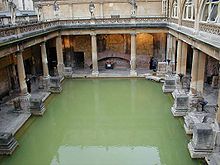
The Romans were one of the first known civilizations to invent indoor plumbing. The Roman public baths
Bathing
Bathing is the washing or cleansing of the body in a fluid, usually water or an aqueous solution. It may be practised for personal hygiene, religious ritual or therapeutic purposes or as a recreational activity....
, or thermae
Thermae
In ancient Rome, thermae and balnea were facilities for bathing...
served hygienic, social and cultural functions. The baths contained three main facilities for bathing. After undressing in the apodyterium
Apodyterium
In ancient Rome, the apodyterium was the primary entry in the public baths, composed of a large changing room with cubicles or shelves where citizens could store clothing and other belongings while bathing....
or changing room, Romans would proceed to the tepidarium
Tepidarium
The tepidarium was the warm bathroom of the Roman baths heated by a hypocaust or underfloor heating system.The specialty of a tepidarium is the pleasant feeling of constant radiant heat which directly affects the human body from the walls and floor.There is an interesting example at Pompeii; this...
or warm room. In the moderate dry heat of the tepidarium, some performed warm-up exercises and stretched while others oiled themselves or had slaves oil them. The tepidarium’s main purpose was to promote sweating to prepare for the next room, the caldarium
Caldarium
right|thumb|230px|Caldarium from the Roman Baths at [[Bath, England]]. The floor has been removed to reveal the empty space where the hot air flowed through to heat the floor....
or hot room. The caldarium, unlike the tepidarium, was extremely humid and hot. Temperatures in the caldarium could reach 40 degrees Celsius
Celsius
Celsius is a scale and unit of measurement for temperature. It is named after the Swedish astronomer Anders Celsius , who developed a similar temperature scale two years before his death...
(104 degrees Fahrenheit). Many contained steam baths and a cold-water fountain known as the labrum
Labrum (architecture)
The labrum in architecture was a large water-filled vessel or basin with an overhanging lip. Marble labrums were a common feature of Roman thermae....
. The last room was the frigidarium
Frigidarium
A frigidarium is a large cold pool of Roman baths. It would be entered after the Caldarium and the Tepidarium, which were used to open the pores of the skin. The cold water would close the pores. There would be a small pool of cold water or sometimes a large Swimming pool...
or cold room, which offered a cold bath for cooling off after the caldarium.
The Romans also had flush toilet
Flush toilet
A flush toilet is a toilet that disposes of human waste by using water to flush it through a drainpipe to another location. Flushing mechanisms are found more often on western toilets , but many squat toilets also are made for automated flushing...
s.
Roman military technology
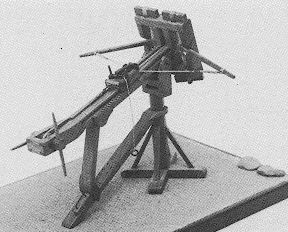
While heavy, intricate armour was not uncommon (cataphracts), the Romans perfected a relatively light, full torso armour made of segmented plates (lorica segmentata
Lorica segmentata
The lōrīca segmentāta was a type of segmented armour almost exclusively used in the Roman Empire, but the Latin name was first used in the 16th century...
). This segmented armour provided good protection for vital areas, but did not cover as much of the body as lorica hamata
Lorica hamata
The lorica hamata is a type of mail armour used by the Roman Republic and the Roman Empire. During the 1st century it was starting to be supplemented by lorica segmentata, but had been reintroduced as sole standard-issue armor by the 4th century. It was issued for both primary Legionary and...
or chainmail. The lorica segmentata provided better protection, but the plate bands were expensive and difficult to produce and difficult to repair in the field. Overall, chainmail was cheaper, easier to produce, cheaper and simpler to maintain, was one-size fits all, and was more comfortable to wear - thus, it remained the primary form of armor even when lorica segmentata was in use.
The Roman cavalry saddle had four horns http://www.caerleon.net/history/army/page9.html and was believed to have been copied from Celtic peoples.
Roman siege engines such as ballista
Ballista
The ballista , plural ballistae, was an ancient missile weapon which launched a large projectile at a distant target....
s, scorpions
Scorpio (dart-thrower)
The scorpio or scorpion was type of Roman artillery piece. Also known by the name of the triggerfish, it was described in detail by Vitruvius...
and onagers were not unique. But the Romans were probably the first people to put ballistas on carts for better mobility on campaigns. On the battlefield, it is thought that they were used to pick off enemy leaders. We have one account of the use of artillery in battle from Tacitus, Histories III,23:
- On engaging they drove back the enemy, only to be driven back themselves, for the Vitellians had concentrated their artillery on the raised road that they might have free and open ground from which to fire; their earlier shots had been scattered and had struck the trees without injuring the enemy. A ballista of enormous size belonging to the Fifteenth legion began to do great harm to the Flavians' line with the huge stones that it hurled; and it would have caused wide destruction if it had not been for the splendid bravery of two soldiers, who, taking some shields from the dead and so disguising themselves, cut the ropes and springs of the machine.
Technologies invented or developed by the Romans
| Technology | Comment |
| Abacus, Roman Roman abacus The Romans developed the Roman hand abacus, a portable, but less capable, base-10 version of the previous Babylonian abacus. It was the first portable calculating device for engineers, merchants and presumably tax collectors... |
Portable. |
| Alum Alum Alum is both a specific chemical compound and a class of chemical compounds. The specific compound is the hydrated potassium aluminium sulfate with the formula KAl2.12H2O. The wider class of compounds known as alums have the related empirical formula, AB2.12H2O.-Chemical properties:Alums are... |
The production of alum (KAl(SO4)2.12H2O) from alunite (KAl3(SO4)2.(OH)6) is archaeologically attested on the island Lesbos. This site was abandoned in the 7th century but dates back at least to the 2nd century AD. |
| Amphitheatre Amphitheatre An amphitheatre is an open-air venue used for entertainment and performances.There are two similar, but distinct, types of structure for which the word "amphitheatre" is used: Ancient Roman amphitheatres were large central performance spaces surrounded by ascending seating, and were commonly used... |
See e.g. Colosseum Colosseum The Colosseum, or the Coliseum, originally the Flavian Amphitheatre , is an elliptical amphitheatre in the centre of the city of Rome, Italy, the largest ever built in the Roman Empire... . |
| Aqueduct Aqueduct An aqueduct is a water supply or navigable channel constructed to convey water. In modern engineering, the term is used for any system of pipes, ditches, canals, tunnels, and other structures used for this purpose.... , true arch |
Pont du Gard Pont du Gard The Pont du Gard is a notable ancient Roman aqueduct bridge that crosses the Gard River in southern France. It is part of a long aqueduct that runs between Uzès and Nîmes in the South of France. It is located in Vers-Pont-du-Gard near Remoulins, in the Gard département... , Segovia Segovia Segovia is a city in Spain, the capital of Segovia Province in the autonomous community of Castile and León. It is situated north of Madrid, 30 minutes by high speed train. The municipality counts some 55,500 inhabitants.-Etymology:... etc. |
| Arch Arch An arch is a structure that spans a space and supports a load. Arches appeared as early as the 2nd millennium BC in Mesopotamian brick architecture and their systematic use started with the Ancient Romans who were the first to apply the technique to a wide range of structures.-Technical aspects:The... , monumental |
|
| Bath, monumental public (Thermae Thermae In ancient Rome, thermae and balnea were facilities for bathing... ) |
See e.g. Baths of Diocletian Baths of Diocletian The Baths of Diocletian in Rome were the grandest of the public baths, or thermae built by successive emperors. Diocletian's Baths, dedicated in 306, were the largest and most sumptuous of the imperial baths. The baths were built between the years 298 AD and 306 AD... |
| Book (Codex Codex A codex is a book in the format used for modern books, with multiple quires or gatherings typically bound together and given a cover.Developed by the Romans from wooden writing tablets, its gradual replacement... ) |
First mentioned by Martial Martial Marcus Valerius Martialis , was a Latin poet from Hispania best known for his twelve books of Epigrams, published in Rome between AD 86 and 103, during the reigns of the emperors Domitian, Nerva and Trajan... in the 1st C. AD. Held many advantages over the scroll. |
| Brass | The Romans had enough understanding of zinc Zinc Zinc , or spelter , is a metallic chemical element; it has the symbol Zn and atomic number 30. It is the first element in group 12 of the periodic table. Zinc is, in some respects, chemically similar to magnesium, because its ion is of similar size and its only common oxidation state is +2... to produce a brass Brass Brass is an alloy of copper and zinc; the proportions of zinc and copper can be varied to create a range of brasses with varying properties.In comparison, bronze is principally an alloy of copper and tin... denomination coinage; see sestertius Sestertius The sestertius, or sesterce, was an ancient Roman coin. During the Roman Republic it was a small, silver coin issued only on rare occasions... . |
| Bridge, true arch Roman bridge Roman bridges, built by ancient Romans, were the first large and lasting bridges built. Roman bridges were built with stone and had the arch as its basic structure.... |
See e.g. Roman bridge in Chaves Roman bridge in Chaves The Roman Bridge at Chaves is an ancient bridge located in the north of Portugal in the town of the same name.- History and construction :The bridge which is in relatively good shape unites the two most important parishes in the town. The bridge is 140 meters long, high and has 12 visible arches... or the Severan Bridge Severan Bridge The Severan Bridge , located near the ancient city Arsameia , north east of Adıyaman in southeastern Turkey, is a Roman bridge... . |
| Bridge, segmental arch | More than a dozen Roman bridges are known to feature segmental (=flat) arches. A prominent example was Trajan's bridge Trajan's bridge Trajan's Bridge or Bridge of Apollodorus over the Danube was a Roman segmental arch bridge, the first to be built over the lower Danube. For more than a thousand years, it was the longest arch bridge in the world, in terms of both total and span length... over the Danube, a lesser known the extant Limyra Bridge Limyra Bridge The Limyra Bridge is a late Roman bridge in Lycia, in modern south-west Turkey, and one of the oldest segmented arch bridges in the world. The long bridge is located near the ancient city of Limyra, and spans the Alakır Çayı river over 26 segmental arches... in Lycia |
| Bridge, pointed arch | Possibly the earliest known bridge featuring a pointed arch is the 5-6th century AD Karamagara Bridge Karamagara Bridge The Karamagara Bridge is a late Roman bridge in the ancient region of Cappadocia in eastern Turkey, and possibly the earliest known pointed arch bridge.- Location and situation:... |
| Camel harness | The harnessing of camels to ploughs is attested in North Africa by the 3rd century AD |
| Cameos | Probably a Hellenistic innovation e.g. Cup of the Ptolemies Cup of the Ptolemies The Cup of the Ptolemies is an onyx or chalcedony cameo two-handled cup , now conserved in the Cabinet des Médailles at the Bibliothèque National, Paris. Until September 1791 it formed part of the treasury of the Basilica of Saint-Denis. It was stolen in 1804, and recovered without its... but taken up by the Emperors e.g. Gemma Augustea Gemma Augustea The Gemma Augustea is a low-relief cameo engraved gem cut from a double-layered Arabian onyx stone. It is commonly agreed that the gem cutter who created the Gemma Augustea was either Dioscurides or one of his disciples, in the second or third decade of the 1st century AD.- Creation and... , Gemma Claudia Gemma Claudia The Gemma Claudia is a Roman five-layered onyx cameo of c.49. It later found its way into the Habsburg collections now in the Kunsthistoriches Museum, Vienna . It is 12 cm high and set in a gold rim.... etc. |
| Cast Iron | Recently archaeologically detected in the Val Gabbia in northern Lombardy from the 5th and 6th centuries AD. This technically interesting innovation appears to have had little economic impact. But archaeologists may have failed to recognize the distinctive slag, so the date and location of this innovation may be revised. |
| Cement Cement In the most general sense of the word, a cement is a binder, a substance that sets and hardens independently, and can bind other materials together. The word "cement" traces to the Romans, who used the term opus caementicium to describe masonry resembling modern concrete that was made from crushed... Concrete Concrete Concrete is a composite construction material, composed of cement and other cementitious materials such as fly ash and slag cement, aggregate , water and chemical admixtures.The word concrete comes from the Latin word... |
Pozzolana Pozzolana Pozzolana, also known as pozzolanic ash , is a fine, sandy volcanic ash. Pozzolanic ash was first discovered and dug in Italy, at Pozzuoli. It was later discovered at a number of other sites as well... variety |
| Crank Crank (mechanism) A crank is an arm attached at right angles to a rotating shaft by which reciprocating motion is imparted to or received from the shaft. It is used to change circular into reciprocating motion, or reciprocating into circular motion. The arm may be a bent portion of the shaft, or a separate arm... handle |
A Roman iron crank handle was excavated in Augusta Raurica Augusta Raurica Augusta Raurica is a Roman archaeological site and an open-air museum in Switzerland. Located on the south bank of the Rhine river about 20 km east of Basel near the villages of Augst and Kaiseraugst, it is the oldest known Roman colony on the Rhine.... , Switzerland. The 82.5 cm long piece with a 15 cm long handle is of yet unknown purpose and dates to no later than ca. 250 AD. |
| Crank and connecting rod Connecting rod In a reciprocating piston engine, the connecting rod or conrod connects the piston to the crank or crankshaft. Together with the crank, they form a simple mechanism that converts linear motion into rotating motion.... |
Found in several water-powered saw mills dating from the late 3rd (Hierapolis sawmill Hierapolis sawmill The Hierapolis sawmill was a Roman water-powered stone sawmill at Hierapolis, Asia Minor . Dating to the second half of the 3rd century AD, the sawmill is the earliest known machine to combine a crank with a connecting rod.... ) to 6th century AD (at Ephesus Ephesus Ephesus was an ancient Greek city, and later a major Roman city, on the west coast of Asia Minor, near present-day Selçuk, Izmir Province, Turkey. It was one of the twelve cities of the Ionian League during the Classical Greek era... respectively Gerasa). |
| Crane, treadwheel | |
| Dam, Arch Arch dam An arch dam is a type of dam that is curved and commonly built with concrete. The arch dam is a structure that is designed to curve upstream so that the force of the water against it, known as hydrostatic pressure, presses against the arch, compressing and strengthening the structure as it pushes... |
Currently best attested for the dam at Glanum Glanum Dam The Glanum Dam, also known as the Vallon de Baume dam, was a Roman arch dam built to supply water to the Roman town of Glanum, the remains of which stand outside the town of Saint-Rémy-de-Provence in south-west France. It was situated south of Glanum, in a gorge that cut into the hills of Les... , France dated ca. 20 BC. The structure has entirely disappeared. Its existence attested from the cuts into the rock on either side to key in the dam wall, which was 14.7 metres high, 3.9m thick at base narrowing to 2.96m at the top. Earliest description of arch action in such types of dam by Procopius Procopius Procopius of Caesarea was a prominent Byzantine scholar from Palestine. Accompanying the general Belisarius in the wars of the Emperor Justinian I, he became the principal historian of the 6th century, writing the Wars of Justinian, the Buildings of Justinian and the celebrated Secret History... around 560 AD, the Dara Dam Dara Dam The Dara Dam was a Roman arch dam at Dara in Mesopotamia , a rare pre-modern example of this dam type. The modern identification of its site is uncertain, but may rather point to a common gravity dam.- Ancient account :... |
| Dam, Arch-gravity Arch-gravity dam An arch-gravity dam, curved-gravity dam or arched dam is a dam with the characteristics of both an arch dam and a gravity dam. It is a dam that curves upstream in a narrowing curve that directs most of the water against the canyon rock walls, providing the force to compress the dam... |
Examples include curved dams at Orükaya, Çavdarhisar Çavdarhisar Çavdarhisar is a town and district of Kütahya Province in the Aegean region of Turkey. According to 2000 census, population of the district is 13,538 of which 4,687 live in the town of Çavdarhisar. The local Kocaçay stream is still crossed by the Roman Penkalas Bridge.-External links:*... , both Turkey (and 2nd c.)Kasserine Dam Kasserine Dam The Kasserine Dam was a Roman dam at Kasserine , Tunisia. The curved structure which dates to the 2nd century AD is variously classified as arch-gravity dam or gravity dam.... in Tunisia, and Puy Foradado Dam Puy Foradado Dam The Puy Foradado Dam was a Roman arch-gravity dam in Zaragoza province, Aragon, Spain, dating to the 2nd or 3rd century AD.- See also :* List of Roman dams and reservoirs* Roman architecture* Roman engineering... in Spain (2nd–3rd c.) |
| Dam, Bridge | The Band-i-Kaisar, constructed by Roman prisoners of war in Shustar, Persia, in the 3rd c. AD, featured a weir Weir A weir is a small overflow dam used to alter the flow characteristics of a river or stream. In most cases weirs take the form of a barrier across the river that causes water to pool behind the structure , but allows water to flow over the top... combined with an arch bridge, a multifunctional hydraulic structure which subsequently spread throughout Iran. |
| Dam, Buttress Buttress dam A buttress dam or hollow dam is a dam with a solid, water-tight upstream side that is supported at intervals on the downstream side by a series of buttresses or supports. The dam wall may be flat or curved. Most buttress dams are made of reinforced concrete and are heavy, pushing the dam into the... |
Attested in a number of Roman dams in Spain, like the 600 m long Consuegra Dam Consuegra Dam The Consuegra Dam was a Roman buttress dam in Toledo province, Castilla-La Mancha, Spain, dating to the 3rd or 4th century AD.- See also :* List of Roman dams and reservoirs* Roman architecture* Roman engineering... |
| Dam, Multiple Arch Buttress | Esparragalejo Dam Esparragalejo Dam The Esparragalejo Dam was a Roman multiple arch buttress dam at Esparragalejo, Badajoz province, Extremadura, Spain. Dating to the 1st century AD, it is the earliest known dam of its kind.... , Spain (1st c. AD) earliest known |
| Dome Dome A dome is a structural element of architecture that resembles the hollow upper half of a sphere. Dome structures made of various materials have a long architectural lineage extending into prehistory.... , monumental |
See e.g. Pantheon Pantheon, Rome The Pantheon ,Rarely Pantheum. This appears in Pliny's Natural History in describing this edifice: Agrippae Pantheum decoravit Diogenes Atheniensis; in columnis templi eius Caryatides probantur inter pauca operum, sicut in fastigio posita signa, sed propter altitudinem loci minus celebrata.from ,... . |
| Foot-powered loom | Before 298 AD, with a hint the invention arose at Tarsus |
| Flos Salis | A product of salt evaporation ponds Dunaliella salina Dunaliella salina Dunaliella salina is a type of halophile green micro-algae especially found in sea salt fields. Known for its anti-oxidant activity because of its ability to create large amount of carotenoids, it is used in cosmetics and dietary supplements. Few organisms can survive in such highly saline... used in the perfume industry (Pliny Nat. Hist. 31,90) |
| Force pump used in fire engine | See image of pointable nozzle |
| Glass blowing | This led to a number of innovations in the use of glass. Window glass is attested at Pompeii in AD 79. In the 2nd century AD hanging glass oil lamps were introduced. These used floating wicks and by reducing self shading gave more lumens in a downwards direction. Cage cups (see photograph) are hypothesised as oil lamps. |
| Dichroic glass as in the Lycurgus Cup. http://www.thebritishmuseum.ac.uk/science/lycurguscup/sr-lycugus-p1.html Note, this material attests otherwise unknown chemistry (or other way?) to generate nano-scale gold-silver particles. | |
| Glass mirrors (Pliny the Elder Pliny the Elder Gaius Plinius Secundus , better known as Pliny the Elder, was a Roman author, naturalist, and natural philosopher, as well as naval and army commander of the early Roman Empire, and personal friend of the emperor Vespasian... Naturalis Historia Naturalis Historia The Natural History is an encyclopedia published circa AD 77–79 by Pliny the Elder. It is one of the largest single works to have survived from the Roman Empire to the modern day and purports to cover the entire field of ancient knowledge, based on the best authorities available to Pliny... 33,130) |
|
| Greenhouse cold frames | (Pliny the Elder Pliny the Elder Gaius Plinius Secundus , better known as Pliny the Elder, was a Roman author, naturalist, and natural philosopher, as well as naval and army commander of the early Roman Empire, and personal friend of the emperor Vespasian... Naturalis Historia Naturalis Historia The Natural History is an encyclopedia published circa AD 77–79 by Pliny the Elder. It is one of the largest single works to have survived from the Roman Empire to the modern day and purports to cover the entire field of ancient knowledge, based on the best authorities available to Pliny... 19.64; Columella Columella Lucius Junius Moderatus Columella is the most important writer on agriculture of the Roman empire. Little is known of his life. He was probably born in Gades , possibly of Roman parents. After a career in the army , he took up farming... on Ag. 11.3.52) |
| Hydraulis Water organ The water organ or hydraulic organ is a type of pipe organ blown by air, where the power source pushing the air is derived by water from a natural source or by a manual pump... |
A water organ. Later also the pneumatic organ. |
| Hushing Hushing Hushing is an ancient and historic mining method using a flood or torrent of water to reveal mineral veins. The method was applied in several ways, both in prospecting for ores, and for their exploitation. Mineral veins are often hidden below soil and sub-soil, which must be stripped away to... |
Described by Pliny the Elder Pliny the Elder Gaius Plinius Secundus , better known as Pliny the Elder, was a Roman author, naturalist, and natural philosopher, as well as naval and army commander of the early Roman Empire, and personal friend of the emperor Vespasian... and confirmed at Dolaucothi and Las Médulas Las Médulas Las Médulas is a historical site near the town of Ponferrada in the region of El Bierzo , which used to be the most important gold mine in the Roman Empire... |
| Hydraulic mining Hydraulic mining Hydraulic mining, or hydraulicking, is a form of mining that uses high-pressure jets of water to dislodge rock material or move sediment. In the placer mining of gold or tin, the resulting water-sediment slurry is directed through sluice boxes to remove the gold.-Precursor - ground... |
Described by Pliny the Elder Pliny the Elder Gaius Plinius Secundus , better known as Pliny the Elder, was a Roman author, naturalist, and natural philosopher, as well as naval and army commander of the early Roman Empire, and personal friend of the emperor Vespasian... and confirmed at Dolaucothi and Las Médulas Las Médulas Las Médulas is a historical site near the town of Ponferrada in the region of El Bierzo , which used to be the most important gold mine in the Roman Empire... |
| Hydrometer Hydrometer A hydrometer is an instrument used to measure the specific gravity of liquids; that is, the ratio of the density of the liquid to the density of water.... |
Mentioned in a letter of Synesius Synesius Synesius , a Greek bishop of Ptolemais in the Libyan Pentapolis after 410, was born of wealthy parents, who claimed descent from Spartan kings, at Balagrae near Cyrene between 370 and 375.-Life:... |
| Hypocaust Hypocaust A hypocaust was an ancient Roman system of underfloor heating, used to heat houses with hot air. The word derives from the Ancient Greek hypo meaning "under" and caust-, meaning "burnt"... |
A floor and also wall heating system. Described by Vitruvius Vitruvius Marcus Vitruvius Pollio was a Roman writer, architect and engineer, active in the 1st century BC. He is best known as the author of the multi-volume work De Architectura .... |
| Knife, multifunctional | http://www.fitzmuseum.cam.ac.uk/opac/search/cataloguedetail.html?&priref=70534&_function_=xslt&_limit_=10 |
| Lighthouses | The best surviving examples are those at Dover castle Dover Castle Dover Castle is a medieval castle in the town of the same name in the English county of Kent. It was founded in the 12th century and has been described as the "Key to England" due to its defensive significance throughout history... and the Tower of Hercules Tower of Hercules The Tower of Hercules is an ancient Roman lighthouse on a peninsula about from the centre of A Coruña, Galicia, in north-western Spain. Until the 20th century, the tower itself was known as the "Farum Brigantium". The Latin word farum is derived from the Greek pharos for the Lighthouse of... at La Coruna |
| Leather, Tanned | The preservation of skins with vegetable tannins was a pre-Roman invention but not of the antiquity once supposed. (Tawing was far more ancient.) The Romans were responsible for spreading this technology into areas where it was previously unknown such as Britain and Qasr Ibrim Qasr Ibrim Qasr Ibrim is an archaeological site in Lower Nubia. It was originally a major city perched on a cliff above the Nile, but the flooding of Lake Nasser after the construction of the Aswan High Dam transformed it into an island and flooded its outskirts. Qasr Ibrim is the only major archaeological... on the Nile. In both places this technology was lost when the Romans withdrew. |
| Mills | M.J.T.Lewis presents good evidence that water powered vertical pounding machines came in by the middle of the 1st c. AD for fulling, grain hulling (Pliny Nat. Hist. 18,97) and ore crushing (archaeological evidence at Dolaucothi Gold Mines Dolaucothi Gold Mines The Dolaucothi Gold Mines , also known as the Ogofau Gold Mine, are Roman surface and deep mines located in the valley of the River Cothi, near Pumsaint, Carmarthenshire, Wales... and Spain). |
| Grainmill, rotary. According to Moritz (p57) rotary grainmills were not known to the ancient Greeks but date from before 160 BC. Unlike reciprocating mills, rotary mills could be easily adapted to animal or water power. Lewis (1997) argues that the rotary grainmill dates to the 5th century BC in the western Mediterranean. Animal and water powered rotary mills came in the 3rd century BC. | |
| Sawmill, water powered. Recorded by 370 AD. Attested in Ausonius's poem Mosella. Translated http://www.parsonsd.co.uk/moselle12.php"the Ruwer sends mill-stones swiftly round to grind the corn, And drives shrill saw-blades through smooth marble blocks". Recent archaeological evidence from Phrygia, Anatolia, now pushes back the date to the 3rd century AD and confirms the use of a crank in the sawmill. | |
| Shipmill, (Though small, the conventional term is "shipmill" not boat mill, probably because there was always a deck, and usually an enclosed superstructure, to keep the flour away from the damp.) where water wheels were attached to boat Boat A boat is a watercraft of any size designed to float or plane, to provide passage across water. Usually this water will be inland or in protected coastal areas. However, boats such as the whaleboat were designed to be operated from a ship in an offshore environment. In naval terms, a boat is a... s, was first recorded at Rome in 547 AD in Procopius of Caesarea's Gothic Wars (1.19.8-29) when Belisaurius was besieged there. |
|
| Steam engine Steam engine A steam engine is a heat engine that performs mechanical work using steam as its working fluid.Steam engines are external combustion engines, where the working fluid is separate from the combustion products. Non-combustion heat sources such as solar power, nuclear power or geothermal energy may be... , essentials of |
By the late 3rd century AD, all essential elements for constructing a steam engine were known by Roman engineers: steam power (in Hero Hero of Alexandria Hero of Alexandria was an ancient Greek mathematician and engineerEnc. Britannica 2007, "Heron of Alexandria" who was active in his native city of Alexandria, Roman Egypt... 's aeolipile Aeolipile An aeolipile , also known as a Hero engine, is a rocket style jet engine which spins when heated. In the 1st century AD, Hero of Alexandria described the device, and many sources give him the credit for its invention.The aeolipile Hero described is considered to be the first recorded steam engine... ), the crank and connecting rod mechanism (in the Hierapolis sawmill Hierapolis sawmill The Hierapolis sawmill was a Roman water-powered stone sawmill at Hierapolis, Asia Minor . Dating to the second half of the 3rd century AD, the sawmill is the earliest known machine to combine a crank with a connecting rod.... ), the cylinder and piston (in metal force pumps), non-return valves (in water pumps) and gearing (in water mills and clocks) |
| Watermill Watermill A watermill is a structure that uses a water wheel or turbine to drive a mechanical process such as flour, lumber or textile production, or metal shaping .- History :... . Improvements upon earlier models. For the largest mill complex known see Barbegal |
|
| Mercury Gilding Gilding The term gilding covers a number of decorative techniques for applying fine gold leaf or powder to solid surfaces such as wood, stone, or metal to give a thin coating of gold. A gilded object is described as "gilt"... |
as in the Horses of San Marco |
| Newspaper, rudimentary | See Acta Diurna Acta Diurna Acta Diurna were daily Roman official notices, a sort of daily gazette. They were carved on stone or metal and presented in message boards in public places like the Forum of Rome... . |
| Odometer Odometer An odometer or odograph is an instrument that indicates distance traveled by a vehicle, such as a bicycle or automobile. The device may be electronic, mechanical, or a combination of the two. The word derives from the Greek words hodós and métron... |
|
| Paddle wheel boats Paddle steamer A paddle steamer is a steamship or riverboat, powered by a steam engine, using paddle wheels to propel it through the water. In antiquity, Paddle wheelers followed the development of poles, oars and sails, where the first uses were wheelers driven by animals or humans... |
In de Rebus Bellicis De Rebus Bellicis De rebus bellicis is a 4th or 5th century anonymous work about war machines used by the Roman army of the time. It was written after the death of Constantine I , and before the fall of the Western Roman Empire... (possibly only a paper invention). |
| Pewter Pewter Pewter is a malleable metal alloy, traditionally 85–99% tin, with the remainder consisting of copper, antimony, bismuth and lead. Copper and antimony act as hardeners while lead is common in the lower grades of pewter, which have a bluish tint. It has a low melting point, around 170–230 °C ,... |
Mentioned by Pliny the Elder Pliny the Elder Gaius Plinius Secundus , better known as Pliny the Elder, was a Roman author, naturalist, and natural philosopher, as well as naval and army commander of the early Roman Empire, and personal friend of the emperor Vespasian... (Naturalis Historia Naturalis Historia The Natural History is an encyclopedia published circa AD 77–79 by Pliny the Elder. It is one of the largest single works to have survived from the Roman Empire to the modern day and purports to cover the entire field of ancient knowledge, based on the best authorities available to Pliny... 34,160-1). Surviving examples are mainly Romano-British of the 3rd and 4th centuries e.g.http://www.romanbaths.co.uk/index.cfm?fuseAction=collection.disp&objectID=batrm_1983_13_c_4 andhttp://www.wessexarch.co.uk/projects/cambridgeshire/cambourne/pewter.html. Roman pewter had a wide range of proportions of tin but proportions of 50%, 75% and 95% predominate (Beagrie 1989). |
| Pleasure lake | An artificial reservoir, highly unusual in that it was meant for recreational rather than utilitarian purposes was created at Subiaco Subiaco, Italy Subiaco is a town and comune in the Province of Rome, in Lazio, Italy, from Tivoli alongside the river Aniene. It is mainly renowned as a tourist and religious resort for its sacred grotto , in the St. Benedict's Abbey, and the other Abbey of St. Scholastica... , Italy, for emperor Nero Nero Nero , was Roman Emperor from 54 to 68, and the last in the Julio-Claudian dynasty. Nero was adopted by his great-uncle Claudius to become his heir and successor, and succeeded to the throne in 54 following Claudius' death.... (54–68 AD). The dam remained the highest in the Roman Empire Roman Empire The Roman Empire was the post-Republican period of the ancient Roman civilization, characterised by an autocratic form of government and large territorial holdings in Europe and around the Mediterranean.... (50 m), and in the world until its destruction in 1305. |
| Plough Plough The plough or plow is a tool used in farming for initial cultivation of soil in preparation for sowing seed or planting. It has been a basic instrument for most of recorded history, and represents one of the major advances in agriculture... |
|
| iron Iron Iron is a chemical element with the symbol Fe and atomic number 26. It is a metal in the first transition series. It is the most common element forming the planet Earth as a whole, forming much of Earth's outer and inner core. It is the fourth most common element in the Earth's crust... -bladed (A much older innovation (e.g. Bible; I Samuel 13,20-1) that became much more common in the Roman period) |
|
| wheeled (Pliny the Elder Pliny the Elder Gaius Plinius Secundus , better known as Pliny the Elder, was a Roman author, naturalist, and natural philosopher, as well as naval and army commander of the early Roman Empire, and personal friend of the emperor Vespasian... Naturalis Historia Naturalis Historia The Natural History is an encyclopedia published circa AD 77–79 by Pliny the Elder. It is one of the largest single works to have survived from the Roman Empire to the modern day and purports to cover the entire field of ancient knowledge, based on the best authorities available to Pliny... 18.171-3) (More important for the Middle Ages, than this era.) |
|
| Pottery, glossed | i.e. Samian ware |
| Reaper Reaper A reaper is a person or machine that reaps crops at harvest, when they are ripe.-Hand reaping:Hand reaping is done by various means, including plucking the ears of grains directly by hand, cutting the grain stalks with a sickle, cutting them with a scythe, or with a later type of scythe called a... |
An early harvesting machine: vallus (Pliny the Elder Pliny the Elder Gaius Plinius Secundus , better known as Pliny the Elder, was a Roman author, naturalist, and natural philosopher, as well as naval and army commander of the early Roman Empire, and personal friend of the emperor Vespasian... Naturalis Historia Naturalis Historia The Natural History is an encyclopedia published circa AD 77–79 by Pliny the Elder. It is one of the largest single works to have survived from the Roman Empire to the modern day and purports to cover the entire field of ancient knowledge, based on the best authorities available to Pliny... 18,296, Palladius Palladius Palladius was the first Bishop of the Christians of Ireland, preceding Saint Patrick. The Roman Catholic Church and the Anglican Communion consider Palladius a saint.-Armorica:... 7.2.2-4 http://www.gnrtr.com/tendencies/en/t08.html) |
| Sails, fore-and-aft rig Fore-and-aft rig A fore-and-aft rig is a sailing rig consisting mainly of sails that are set along the line of the keel rather than perpendicular to it. Such sails are described as fore-and-aft rigged.... |
Introduction of fore-and-aft rigs 1) the Lateen Lateen A lateen or latin-rig is a triangular sail set on a long yard mounted at an angle on the mast, and running in a fore-and-aft direction.... sail 2) the Spritsail Spritsail The spritsail is a form of three or four-sided, fore-aft sail and its rig. Unlike the gaff where the head hangs from a spar along its edge, this rig supports the leech of the sail by means of a spar or spars named a sprit... , this last already attested in 2nd century BC in the northern Aegean Sea Aegean Sea The Aegean Sea[p] is an elongated embayment of the Mediterranean Sea located between the southern Balkan and Anatolian peninsulas, i.e., between the mainlands of Greece and Turkey. In the north, it is connected to the Marmara Sea and Black Sea by the Dardanelles and Bosporus... Note: there is no evidence of any combination of fore and aft rigs with square sails on the same Roman ship. |
| Sails, Lateen | Representations show lateen sails in the Mediterranean as early as the 2nd century AD. Both the quadrilateral and the triangular type were employed. |
| Roller Bearings | Archaeologically attested in the Lake Nemi ships Nemi ships The Nemi Ships were ships built by the Roman emperor Caligula in the 1st century AD at Lake Nemi. Although the purpose of the ships is only speculated on, the larger ship was essentially an elaborate floating palace, which contained quantities of marble, mosaic floors, heating and plumbing such as... |
| Rudder, stern-mounted | See image for something very close to being a sternpost rudder |
| Sausage, fermented dry (probably) | See salami Salami Salami is cured sausage, fermented and air-dried meat, originating from one of a variety of animals. Historically, salami has been popular among Southern European peasants because it can be stored at room temperature for periods of up to 10 years, supplementing a possibly meager or inconsistent... . |
| Screw press | An innovation of about the mid 1st century AD |
| Sewers Sanitary sewer A sanitary sewer is a separate underground carriage system specifically for transporting sewage from houses and commercial buildings to treatment or disposal. Sanitary sewers serving industrial areas also carry industrial wastewater... |
See for example Cloaca Maxima Cloaca Maxima The Cloaca Maxima is one of the world's earliest sewage systems. Constructed in Ancient Rome in order to drain local marshes and remove the waste of one of the world's most populous cities, it carried an effluent to the River Tiber, which ran beside the city.... |
| Soap, hard (sodium) | First mentioned by Galen Galen Aelius Galenus or Claudius Galenus , better known as Galen of Pergamon , was a prominent Roman physician, surgeon and philosopher... (earlier, potassium, soap being Celtic). |
| Spiral staircase Spiral staircase Spiral staircase may refer to:* A type of stairway characterized by its spiral shape* The Spiral Staircase , a 1946 American psychological thriller film* The Spiral Staircase , a 1975 British film, a remake of the 1946 film... |
Though first attested as early as the 5th century BC in Greek Selinunte Selinunte Selinunte is an ancient Greek archaeological site on the south coast of Sicily, southern Italy, between the valleys of the rivers Belice and Modione in the province of Trapani. The archaeological site contains five temples centered on an acropolis... , spiral staircases only become more widespread after their adoption in Trajan's column Trajan's Column Trajan's Column is a Roman triumphal column in Rome, Italy, which commemorates Roman emperor Trajan's victory in the Dacian Wars. It was probably constructed under the supervision of the architect Apollodorus of Damascus at the order of the Roman Senate. It is located in Trajan's Forum, built near... and the Column of Marcus Aurelius Column of Marcus Aurelius The Column of Marcus Aurelius is a Roman victory column in Piazza Colonna, Rome, Italy. It is a Doric column featuring a spiral relief: it was built in honour of Roman emperor Marcus Aurelius and modeled on Trajan's Column.- Construction :... . |
| Stenography, a system of | See Tironian notes Tironian notes Tironian notes is a system of shorthand said to have been invented by Cicero's scribe Marcus Tullius Tiro. Tiro's system consisted of about 4,000 signs, somewhat extended in classical times to 5,000 signs. In the European Medieval period, Tironian notes were taught in monasteries and the system... . |
| Street map, early | See Forma Urbis Romae Forma Urbis Romae The Forma Urbis Romae or Severan Marble Plan is a massive marble map of ancient Rome, created under the emperor Septimius Severus between 203 and 211... (Severan Marble Plan), a carved marble ground plan of every architectural feature in ancient Rome. |
| Sundial, portable | See Theodosius of Bithynia Theodosius of Bithynia Theodosius of Bithynia was a Greek astronomer and mathematician who wrote the Sphaerics, a book on the geometry of the sphere. Born in Tripolis, in Bithynia, Theodosius is cited by Vitruvius as having invented a sundial suitable for any place on Earth... |
| Surgical instruments Surgical instruments A surgical instrument is a specially designed tool or device for performing specific actions of carrying out desired effects during a surgery or operation, such as modifying biological tissue, or to provide access for viewing it. Over time, many different kinds of surgical instruments and tools... , various |
|
| Tooth implants, iron | See http://news.bbc.co.uk/1/hi/sci/tech/43705.stm |
| Towpath | e.g. beside the Danube, see the "road" in Trajan's bridge Trajan's bridge Trajan's Bridge or Bridge of Apollodorus over the Danube was a Roman segmental arch bridge, the first to be built over the lower Danube. For more than a thousand years, it was the longest arch bridge in the world, in terms of both total and span length... |
| Tunnels | Excavated from both ends simultaneously. The longest known is the 5.6 kilometres (3.5 mi) drain of the Fucine lake Fucine Lake The Fucine Lake was a large lake in central Italy, stretching from Avezzano in the northwest to Ortuccio in the southeast, and touching Trasacco in the southwest. It was drained in 1875.-Roman drainage:... |
| Vehicles, one wheeled | Solely attested by a Latin word in 4th C. AD Scriptores Historiae Augustae Heliogabalus 29. As this is fiction, the evidence dates to its time of writing. |
| Wood veneer Wood veneer In woodworking, veneer refers to thin slices of wood, usually thinner than 3 mm , that are typically glued onto core panels to produce flat panels such as doors, tops and panels for cabinets, parquet floors and parts of furniture. They are also used in marquetry... |
Pliny Nat. Hist. 16.231-2 |
See also
Overview- Roman architectureRoman architectureAncient Roman architecture adopted certain aspects of Ancient Greek architecture, creating a new architectural style. The Romans were indebted to their Etruscan neighbors and forefathers who supplied them with a wealth of knowledge essential for future architectural solutions, such as hydraulics...
- Roman aqueducts
- Roman engineeringRoman engineeringRomans are famous for their advanced engineering accomplishments, although some of their own inventions were improvements on older ideas, concepts and inventions. Technology for bringing running water into cities was developed in the east, but transformed by the Romans into a technology...
- Roman metallurgyRoman metallurgyMetals and metal working had been known to the people of modern Italy since the Bronze Age. By 86 BC, Rome had already expanded to control an immense expanse of the Mediterranean...
- Roman mining
- Maritime hydraulics in antiquityMaritime hydraulics in antiquityWith the issue of supplying water to a very large population, the Romans developed hydraulic systems for multiple applications: public water supply, power using water mills, hydraulic mining, fish tanks, irrigation, fire fighting, and of course aqueduct...
Selected works and writers
- Frontinus
- De ArchitecturaDe architectura' is a treatise on architecture written by the Roman architect Vitruvius and dedicated to his patron, the emperor Caesar Augustus, as a guide for building projects...
- Naturalis HistoriaNaturalis HistoriaThe Natural History is an encyclopedia published circa AD 77–79 by Pliny the Elder. It is one of the largest single works to have survived from the Roman Empire to the modern day and purports to cover the entire field of ancient knowledge, based on the best authorities available to Pliny...
Other lists
- Ancient Greek technologyAncient Greek technologyAncient Greek technology developed at an unprecedented speed during the 5th century BC, continuing up to and including the Roman period, and beyond...
- History of science in Classical AntiquityHistory of science in Classical AntiquityThe history of science in classical antiquity encompasses both those inquiries into the workings of the universe aimed at such practical goals as establishing a reliable calendar or determining how to cure a variety of illnesses and those abstract investigations known as natural philosophy...
- Medieval technologyMedieval technologyMedieval technology refers to the technology used in medieval Europe under Christian rule. After the Renaissance of the 12th century, medieval Europe saw a radical change in the rate of new inventions, innovations in the ways of managing traditional means of production, and economic growth...
- Science in Medieval Western Europe
- List of Byzantine inventions
- Renaissance technologyRenaissance technologyRenaissance technology is the set of European artifacts and customs which span the Renaissance period, roughly the 14th through the 16th century. The era is marked by profound technical advancements such as the printing press, linear perspective in drawing, patent law, double shell domes and...
External links
- Traianus – Technical investigation of Roman public works
- Roman Traction Systems – Horse, harness, wagon
- Roman Horse Harnesses – With pictorial evidence
- Roman Concrete – Roman concrete buildings



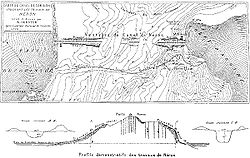
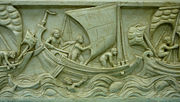
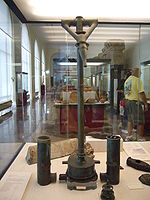
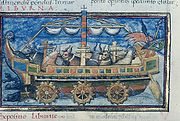
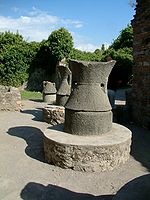
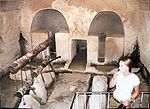
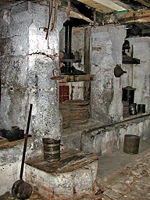
.jpg)
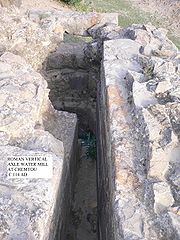


_-_n._11141_-_museo_di_napoli_-_strumenti_di_chirurgia.jpg)
